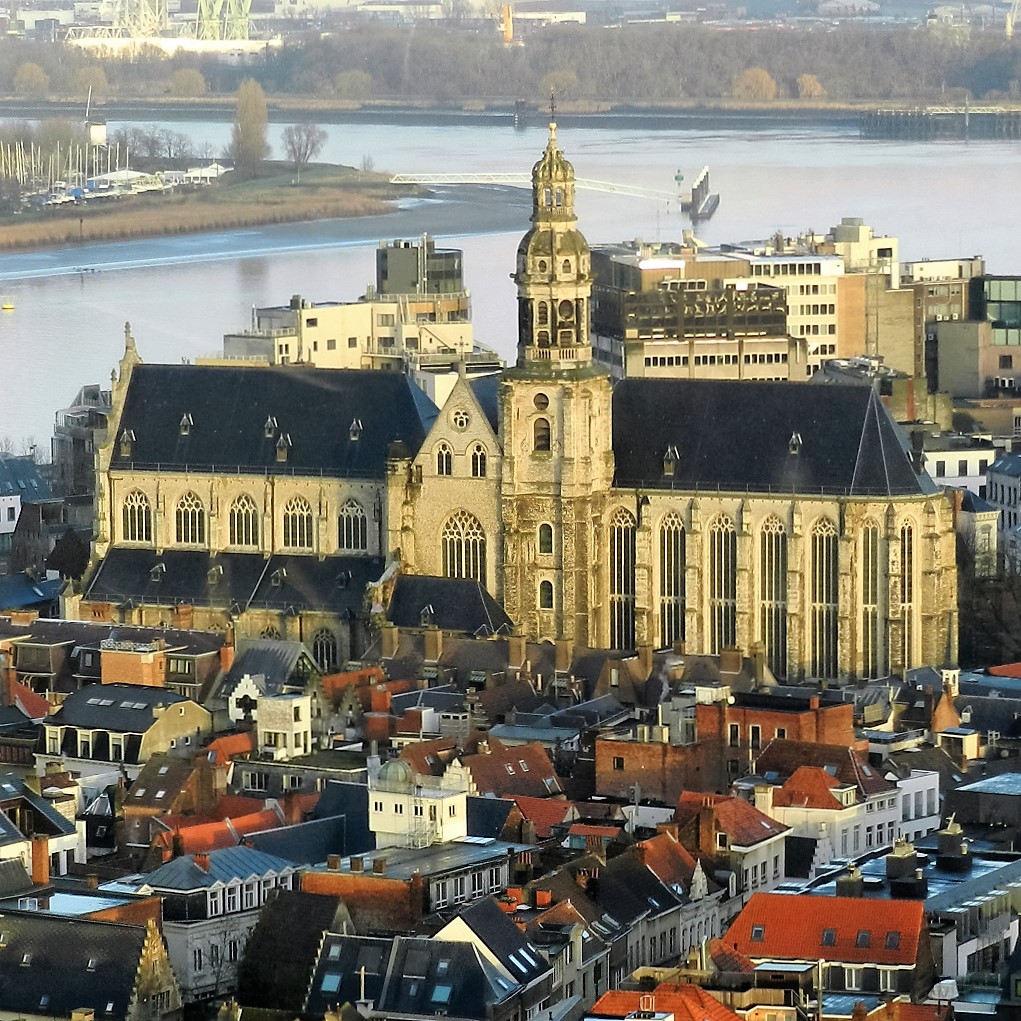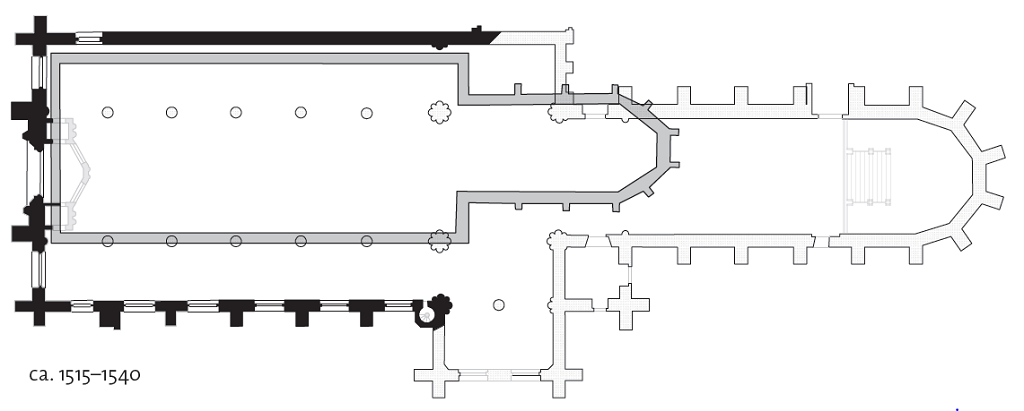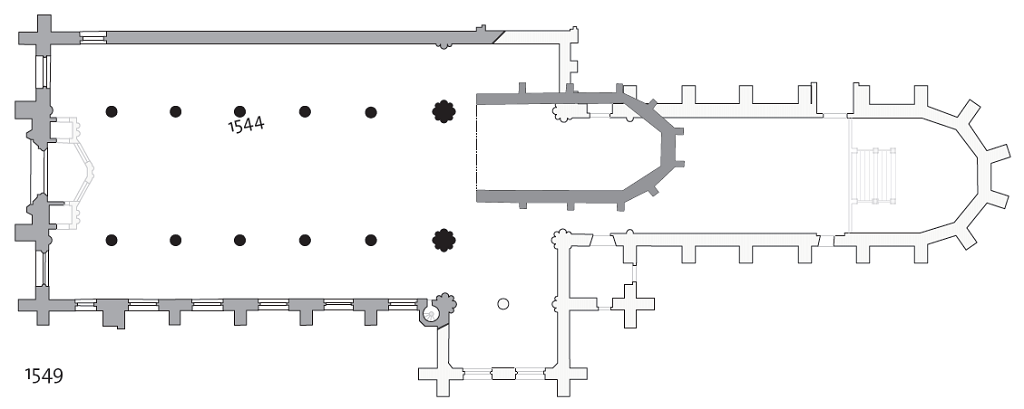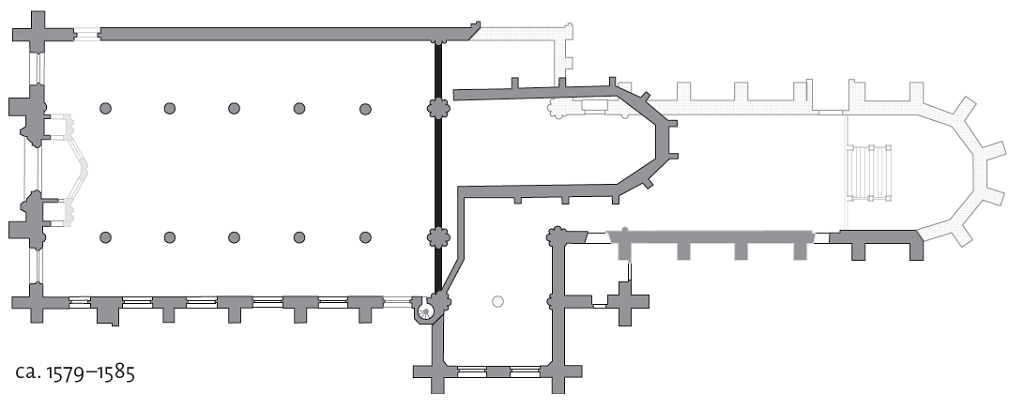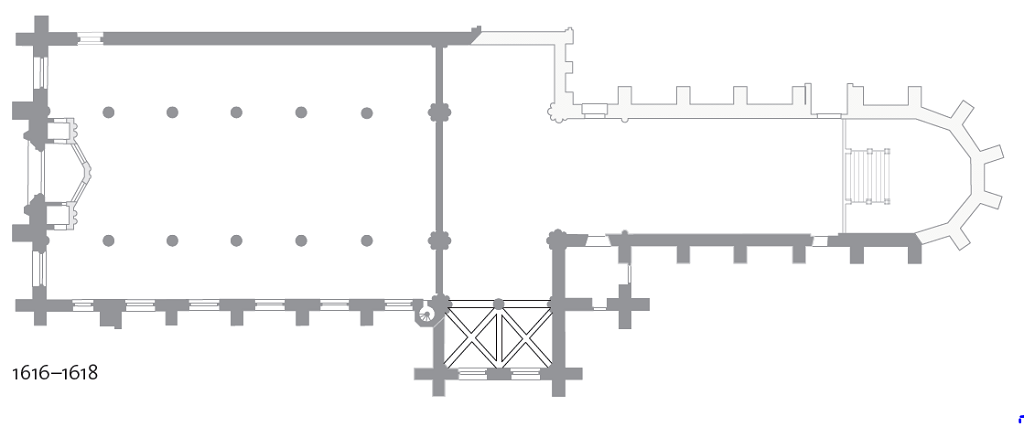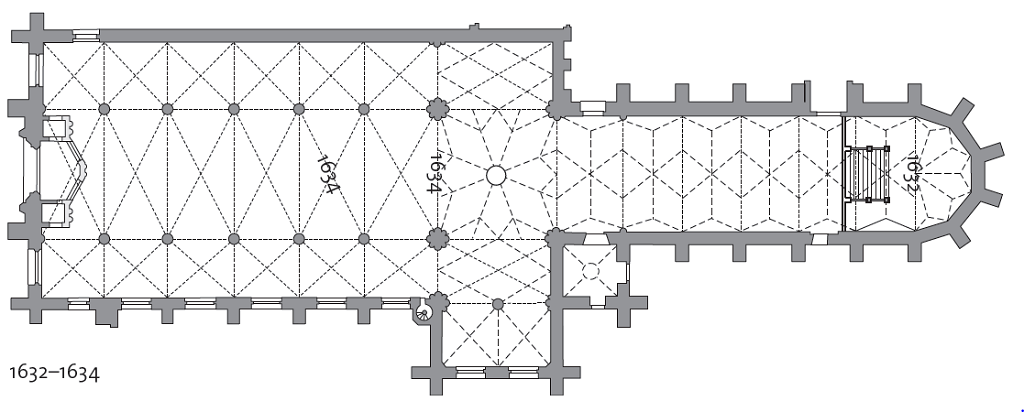Saint Paul’s, the Antwerp Dominican church, a revelation
A century-long building history
The first gothic church (1262-1276)
The first Dominicans arrived in Antwerp in 1243, partly because of the Antwerp city government’s request to counteract the heresy of Catherism. They settled in the street that later was called Prekersstraat (Preachers Street), after them. Canon Hugo Nose gave them a large plot at Dries, which became part of the new city expansion. In 1256 the religious community moved to a new estate in present Nosestraat. Zwartzusterstraat (Blacksisters Street) was originally called ‘Jakobijnstraat’ (Jacobin Street), after the popular name for the order.
In 1262 the Dominicans started the construction of their first monastery church, at the southern end of their plot, near the city centre. Because the bishop (of Cambrai) begged to be excused for the consecration, someone of their own order of Episcopal status was allowed to consecrate the church in 1276, the famous scholar Albertus Magnus. The consecration act of this first Saint Paul’s Church is being cherished as one of the most precious records in the treasury. The building was 30 feet tall; only the choir and the sacristy were vaulted. The choir was screened off by a rood loft with side altars.
In 1995-1996 archaeological excavations partly brought to light the springing line of the three-aisled Gothic monastery church, as well as walls and pillars. This church was situated 3.70m (12.14ft) below the present floor. This place of worship, which had a length of nearly 55m (180ft), covered the present nave, the transepts and the first bays of the present choir. The pillars, of Tournai limestone, 70cm (2.3ft) in diameter, had decorative, profiled bases. Also a nice Gothic corbel was found, with an angel with a banderol, which was part of the monastery gate (ca. 1400).

In 1444 the Dominicans built a large premises with covered galleries, where mainly goldsmiths, silversmiths and jewellers displayed their articles during the two annual fairs. Since 1479 the goldsmiths’ guild also had a private chapel at their disposal, situated near the choir, and this was dedicated to their patron, Eloy or Eligius.
Since due to the 1421-1423 Saint-Elisabeth’s Floods the river Scheldt flowed into the North Sea closer to the city. As a result Antwerp, which is situated low, suffered floodings. Also in the Dominican church water was a regular(Adj.) This is said of a priest who is a member of a religious order and therefore submits to the rule of this order and owes obedience to the superior of his (monastic) community. visitor. The only solution was to level up the monastery plot and the surrounding streets. This is why the Antwerp Chronicle mentions “an ugly dark church, into which one used to go down”. For a more spectacular incident fire was responsible. On 6th July 1477 lightning struck the altar of no one less than the founder of the order, Dominic, and caused his statue to tumble off the altar steps.
The present gothic church (as from ca. 1512)
In about 1512, during the rise of Antwerp’s ‘Golden Age’, the Preachers started the construction of a big Gothic church. The architects were possibly Domien de Waghemakere and, after the latter’s death in 1542, certainly Rombout de Dryvere. To solve the problem of the rising water definitively the whole plot around the existing church was levelled up to a bank rising 1.60 m (= 5.25ft) above the present street level. The street level itself at the side entrance in Veemarkt was raised about 0.70 m (=2.3 ft).
Also a new refectory and dormitory was built. In 1540 the construction of the aisles could be continued. A strange inscription on the northern central pillar alludes to this building phase.
In 1549 the construction of the lower church had progressed so much that the naveThe rear part of the church which is reserved for the congregation. The nave extends to the transept. of the first church could be pulled down. The next year the silversmiths’ premises was demolished to build the southern aisleLengthwise the nave [in exceptional cases also the transept] of the church is divided into aisles. An aisle is the space between two series of pillars or between a series of pillars and the outer wall. Each aisle is divided into bays.. The services could already be held in the church, which was under construction. In 1556 this was repeatedly the case in the presence of King Philip II.

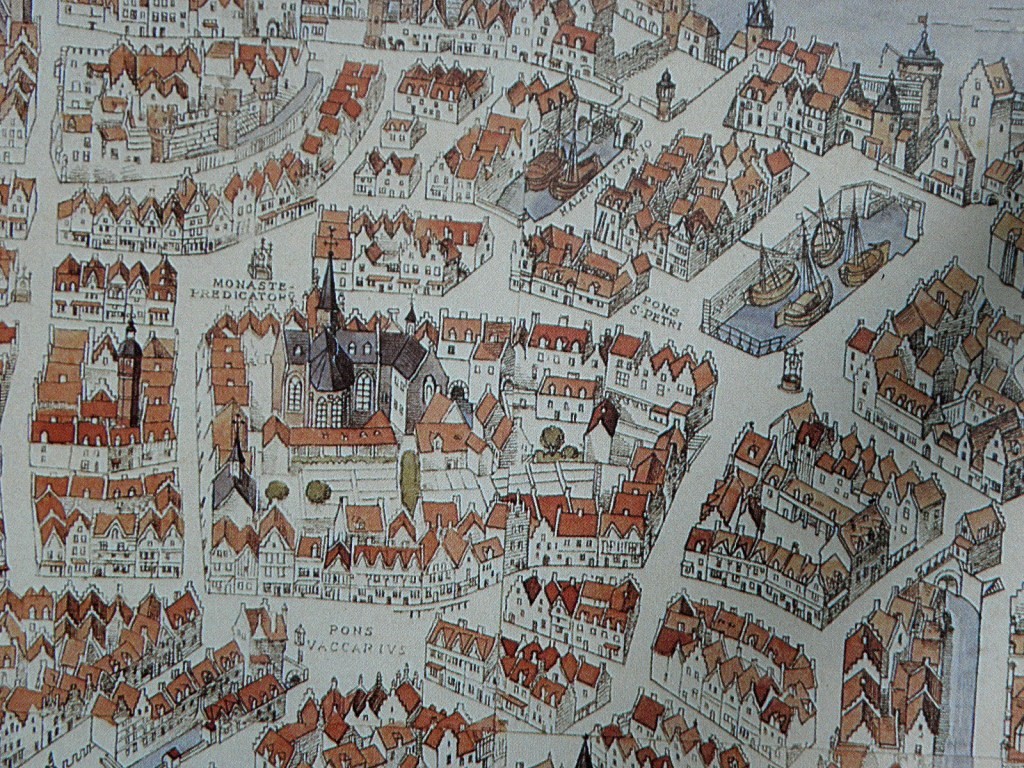
At the first iconoclast fury of 22nd/23rd August 1566 a small gang destroyed the SaintThis is a title that the Church bestows on a deceased person who has lived a particularly righteous and faithful life. In the Roman Catholic and Orthodox Church, saints may be venerated (not worshipped). Several saints are also martyrs. Eligius altarThe altar is the central piece of furniture used in the Eucharist. Originally, an altar used to be a sacrificial table. This fits in with the theological view that Jesus sacrificed himself, through his death on the cross, to redeem mankind, as symbolically depicted in the painting “The Adoration of the Lamb” by the Van Eyck brothers. In modern times the altar is often described as “the table of the Lord”. Here the altar refers to the table at which Jesus and his disciples were seated at the institution of the Eucharist during the Last Supper. Just as Jesus and his disciples did then, the priest and the faithful gather around this table with bread and wine. of the silversmiths.
In the southern aisle a few grisaille wall paintings in Mannerist style date back to the first reconstruction period, i e of 1570 and 1577. This also goes for the wall painting of the “Mystic Winepress”.
In 1571, only five days after he had been enthroned as bishopPriest in charge of a diocese. See also ‘archbishop’. of Haarlem in Antwerp CathedralThe main church of a diocese, where the bishop’s seat is., the Domican Godfried van Mierlo consecratedIn the Roman Catholic Church, the moment when, during the Eucharist, the bread and wine are transformed into the body and blood of Jesus, the so-called transubstantiation, by the pronouncement of the sacramental words. the nave, containing five altars.
The building plans were further directed to the walls of the Southern transeptThe transept forms, as it were, the crossbeam of the cruciform floor plan. The transept consists of two semi transepts, each of which protrudes from the nave on the left and right. and the Southern wall of the choirIn a church with a cruciform floor plan, the part of the church that lies on the side of the nave opposite to the transept. The main altar is in the choir., but they were stopped by the circumstances at that time.
When in 1577 Antwerp turned against the lawful ‘Spanish’ authorities the Calvinists dominated the urban government. First there was religious tolerance, but as soon as in 1578 the protestants got a few churches. These were mostly divided according to the same pattern: the Catholics kept the altar spaces of the choir and the transepts, the Calvinists obtained the nave and aisles – with the pulpit – as a hall church. On 4th October this was decided for the Dominican church, among others. At the city’s expense the old choir would be “separated and hidden” from the new church by a wall and remained reserved to the friars. But the Protestants were not that patient and the next day they already took possession of the church, without the prescribed wall having been erected. That this could disturb the friars’ services was not their concern.
Only half a year later, at the second religious truce in 1579, the influential mendicant orders, such as the Dominicans, were banished. In 1580 church property was confiscated and monasteries were abolished. In the former monasteryComplex of buildings in which members of a religious order live together. They follow the rule of their founder. The oldest monastic orders are the Carthusians, Dominicans, Franciscans, and Augustinians [and their female counterparts]. Note: Benedictines, Premonstratensians, and Cistercians [and their female counterparts] live in abbeys; Jesuits in houses. a canonSomeone who, together with other canons, is attached to a cathedral or collegiate church and whose main task is to ensure choral prayer. foundry and a hospital were housed. The church was entirely assigned to the Calvinists. The result: a premeditated ‘purification’ of Catholic visual material, i.e. removal and destruction. To get over and done with the Dominican papist institution, the commission decided to parcel out the monastic premises, so that the greater part of the cloisters had to be pulled down. Two streets were laid out across it.
Probably the Calvinists did build a partition to separate the (old) choir from the (new) nave, in order to create a more oblong building, which allowed them to gather around the Word (without an altar).
When in 1584, at the siege of Antwerp, Farnese isolated the town by laying a pontoon bridge across the Scheldt, the rebellious Antwerpians tried to destroy this with fire ships. As ballast they used building material of the Dominican church, which not long before had been under construction. This was of no avail however. Antwerp fell to the lawful Spanish authorities, which fully supported Catholicism.
The Blackfriars returned and were given back their properties. The allotment could be done away with. The empty church was consecrated anew for Catholic service and the Preachers started working. First (the nave of) the church was decorated. Gradually the monastery was rebuilt at a larger scale. In 1603 the archduke Albert and archduchess Isabella paid a visit. To redecorate the altars with large painted triptychs an appeal was made to Mannerist painters such as Marten Pepijn with The Holy Kinship.
Apparently the restoration of the altars didn’t go too quickly, since for two altars the commission was only given in about 1608, to Peter Paul Rubens, who had just come back from Italy. The altars for which both pieces were meant were at that moment still against the wall that separated the nave and the transepts from the choir.
The chapel
A small church that is not a parish church. It may be part of a larger entity such as a hospital, school, or an alms-house, or it may stand alone.
An enclosed part of a church with its own altar.
next to the southern transept was granted to the Brotherhood (or Sodality) of the Sweet Name of Jesus, which in 1616 had it vaulted at their costs and had it furnished that same year.
In 1618, during the Twelve Years’ Truce, under the priorate of Michaël Ophovius, the Dominicans restarted the construction. Bishop Johannes Malderus laid the first stone, as a start of the extension of the transept and of the gigantic choir, which was started in 1624. Because unity of style was aimed at the traditional Gothic style was used in full Baroque period. In 1628 the traditional tree crowned the top of the apseSemi-circular or polygonal extension where the high altar is located in a church..
In the vaulting of the apse one can see the date “1632” and Ophovius’ coat of arms. Two years later the central naveThe space between the two central series of pillars of the nave. was vaulted: the date “1634” is to be found both on a rib of the vaulting in the central nave, and on the keystone on the arch between the nave and the crossingThe central point of a church with a cruciform floor plan. The crossing is the intersection between the longitudinal axis [the choir and the nave] and the transverse axis [the transept].. The wall between the nave and the choir was demolished, so that for the first time the grandiose church interior that we know today was unfolded as a revelation of God’s greatness and of the zest of Counter -Reformation. The final result of about 120 years of construction: a three-aisled cruciform church with an immense choir, with a total length of 88 m (288 ft).
The side altars of the Sweet of Name of Jesus and the Holy SacramentIn Christianity, this is a sacred act in which God comes to man. Sacraments mark important moments in human life. In the Catholic Church, there are seven sacraments: baptism, confession, Eucharist, confirmation, anointing of the sick, marriage and ordination., and that of Our Lady of the Rosary were removed, together with their marble gardens, from the far ends of the aisles to their present positions in the transepts. So it is with suitable pride that they had the newly redecorated church interior recorded in painting by Pieter I Neefs (Rijksmuseum Amsterdam).
Once the choir stallsA series of seats, usually in wood, along the long sides of the choir. These seats are reserved for those who pray and sing the choir prayers., which had to help realize the core-business in the choir, had been installed, the Antwerp bishop Gaspar Nemius could consecrate the choir with the high altar, as well as the transepts and the four side altars in 1639.
In the further course of the 17th century the church was richly decorated with Baroque furniture. The monumental Our Lady’s altar in the northern transept (1650) received a counterpart in the southern transept six years later: the Holy Sacrament altar (Peter I Verbruggen), for which later Rubens’ painting The ecclesiastical dispute of the Holy Sacrament was enlarged. Together with the marble choir screen Peter I Verbruggen built two side altars against it in 1654-1655: at the southern side that of the Holy Cross and at the northern one that of Saint Dominic. In 1670 the impressive marble high altar (Peter I and II Verbruggen) followed. The great organ (Nicolas van Haegen) has filled the entire western wall since 1654-1658 and in 1658-1660 the confessionals and panelling were replaced by the present High Baroque ones (Peter I Verbruggen?).
On 1st June 1679 lightning struck the small crossing tower. Both the burning roof of the central nave and the crowning of the western facade crashed through the vaultings. This caused great damage to the big organ. The Gothic gable was replaced by a simple hipped roof, because in 1680-’81 all attention was absorbed by the true Baroque tower by architect Nicolaes Millich.
In 1700-1707 the remarkable Mount Calvary was constructed against the southern wall and chapel next to the southern transept. This gave rise to the garden of sculptures, at which several sculptors worked until 1741: the so-called Calvary garden. The last striking intervention was the choir organ by Jean-Baptiste Forceville (1720-1722), which was known as the “silver organ”.


The end of the 18th century introduced another period of misfortune, now in the name of Enlightenment. First ‘the price of fame’ had to be paid, when Our Lady of the Rosary by Caravaggio found its way to the imperial art collection in Vienna. Afterwards there were the more general ecclesiastic interferences by Emperor Joseph II of Austria. In 1784 he forbade burials in churches and towns. The new graveyard Stuivenberg became the final resting place of the parishioners of the northern half of the city. With one of his next laws the ‘Emperor-Sacristan’ abolished the brotherhoods in 1786.
In 1794 our provinces were occupied by the French Revolutionary Rule and because of the war taxes that were imposed the church silver had to be sold. The most important paintings by Rubens, Van Dyck and Jordaens were taken to the central storage in France as war booty. In 1796 all monastic communities that did not dedicate themselves to education or nursing were disbanded. At their expulsion each Dominican received a voucher in exchange for their property. Hoping to be able to buy their convent back they did accept them. About the same time the greater part of the archives disappeared: a great loss for the historiography of the convent and the church. Still 631 files are to be found in Saint Paul’s archives, from the first Dominicans in the 13th till the last ones in the 19th century.
In 1797 the church was sold publically. Because the preachers deliberately parted with their vouchers, prior Peltiers, helped by parishioners of Saint Walburga parish, could buy the church and the convent back. A few Dominicans resided again in their convent, now as ‘citoyens’, hoping to be able to found a new Dominican community once. However, the French administration saw through Peltiers’ plans to re-open the church for service. He sold the church and the convent to a straw man and – contrary to most persecuted religious – on 9th May 1798 he swore the oath of hatred against the French monarchy, hoping to re-open the church.
When in 1800 the Consulate, with general Napoleon Bonaparte, allowed individual owners to open their churches for service, Peltiers was one of the first in Antwerp to open his church. One year later, with the Concordat, the parishes were re-established. Because the Antwerp Diocese had been abolished, the Antwerp parishes came under the Malines ArchbishopricThe bishop in charge of the archdiocese. In actual practice, this also means that he is the head of the church province.. Saint Walburga Church, near the Steen, which was still used as a marine depot, was considered too ramshackle. Hence the question arose of opening the former Dominican church as a parish church. To this end the town government bought Saint Paul’s Church from Peltiers in 1803. As a result the City of Antwerp has been the owner of the church until today. Thanks to this new function Saint Paul’s was saved definitively. Moreover it became the heir of the brotherhoods of the Saint Walburga parish (Saint Loy, Saint John of Nepomuk and Saint Lucy) and their works of art. Dominican fatherPriest who is a member of a religious order. Alexander Stordeur became the first parish priestA priest in charge of a parish. of Saint Paul’s parish. The presbytery was established in the former guest wing.
In 1815 a great deal of the paintings that had been stolen from Antwerp churches came back from Paris. Saint Paul’s could welcome again its paintings by Rubens, Van Dyck and Jordaens. The two paintings of the high altar however, which had already been dispatched to regional museums, have unjustly remained in France.
In 1816 Prior Peltiers offered the convent buildings to the committee of church wardens. The great ‘saviour of the convent’ died there five years later. The last Antwerp Dominican died there in 1846.
During the bombarding of the town by the Dutch on 27th October 1830 all 17th century colourful stained glass windows, made after cartoons by Abraham Van Diepenbeeck, were destroyed. Since then the bleakness of the choir and the southern aisle has been fiercely contrasting with the magnificent display of colour of the paintings cycle in the northern aisle.
In 1833 the drastic adaptation of the convent church into a parish church was finally started. The most important aspect is the outlook on the high altar, which had used to be the private altar of the Dominicans, but had been the parish altar for all believers since 1801. To that end the monumental Baroque choir screen, together with the two side altars, were pulled down. The southern altar, devoted to the Holy Cross, was removed to the annex of the southern transept: ‘The (small) Vision of Saint Dominic’ by Gaspar De Crayer was put against the wall of that transept. Is it not astonishing?! First this church and all its works of art exceptionally survived the revolutionary rule of occupiers and was then, in independent Belgium, assailed by its own committee of church wardens!
True to the view that baptismThrough this sacrament, a person becomes a member of the Church community of faith. The core of the event is a ritual washing, which is usually limited to sprinkling the head with water. Traditionally baptism is administered by a priest, but nowadays it is often also done by a deacon. is the condition to enter the church community, a separate baptistery was built near the entrance of the church, in the corner of the Calvary garden, close to the only entrance at that time, the one at Veemarkt. We must not forget that Sint-Paulusstraat had not been laid yet. As baptismal fontThe stone or metal vessel containing holy water, used for administering baptism. Often the baptismal font is/was located in a specially designed baptistery, usually close to the entrance of the church. the round marble holy-water fontA small basin at the entrance of a church, containing holy water so that the faithful may sprinkle themselves with it when entering the church, while making the sign of the cross, as a symbol of outward and inward cleansing. from the former Saint Walburga church was used. In about 1850 a wedding chapel was created by closing off half the southern cloisters (the present week chapel).
In order to connect Meir with the Scheldt by “wide, modern streets” Sint-Paulusstraat was opened, across the former convent gardens in 1855. The committee of church wardens commissioned Bartholomeus De Proost to construct 12 houses in that street, 6 at each side of the entrance building in classicistic style (1859-1562), which became the new entrance to the parish church. This fits in with the neo-Baroque ‘lion gates’ in the choir.
In 1889 windows and roofs were damaged by the explosion of the Corvilain gunpowder factory. Thanks to neo-Gothic fashion the frontage was rebuilt by François Baeckelmans, mainly true to the original Gothic outlook (1895-1901). The urban development ideal of having a free view on ‘monuments’ resulted in the demolishing of the two houses that used to be against the façade at the level of the aisles.
The church has been a listed monument since 1939, but this did not prevent the German occupiers during the Second World War requisitioning two chiming bells to provide their war engine with feedstock in 1943. Because of the threat of force of arms in that same year many a work of art was literally protected, especially freestanding statues, such as Saint Rosa, the Flagellated Christ, Our Lady’s throne, the funeral monuments in the choir and all the confessionals.
Since 1961 Saint Paul’s parish has been part of the re-established Antwerp diocese.
In the night of 2nd to 3rd April 1968 a catastrophic fire destroyed the convent buildings and the fire leapt on to the church roof and so reached the tower. Fortunately the vaultings held out. Only the wooden lid of the old bells hole (of the fleche of before 1679) in the middle of the stellar vault of the crossing collapsed, causing a cascade of sparks to fall down: the ultimate moment to make the best of a bad job. In the meantime a lot of volunteers of the neighbourhood had broken the statues out of the confessionals, had taken ladders to cut canvases out of their frames and rolled them up, and had taken the treasures from the sacristyThe room where the priest(s), the prayer leader(s) and the altar server(s) and/or acolyte(s) prepare and change clothes for Mass.. At this heroic evacuation nothing was ‘lost’. From the criticism afterwards, once more the Dutch saying proved to be true: the best skippers are ashore.
The global restoration took years. In 1977-1982 the upper part of the tower was completely rebuilt, but the urgent restoration of the roof, with a steel truss, was completed only in 1988. Still under the lead of architect Louis Williame the entire exterior was thoroughly tackled from 1991 till 1993. From 1994 till 1998 architect Rutger Steenmeijer led the restoration of the interior. The installation of underfloor heating was a lifetime opportunity for archaeological investigations: tombs, foundations and the old little church and convent were brought to light.
In 1998 the committee of church wardens sold the convent buildings and the old presbytery in the former guest wing.
Three years later, in 2001, the treasury was opened next to the choir.
